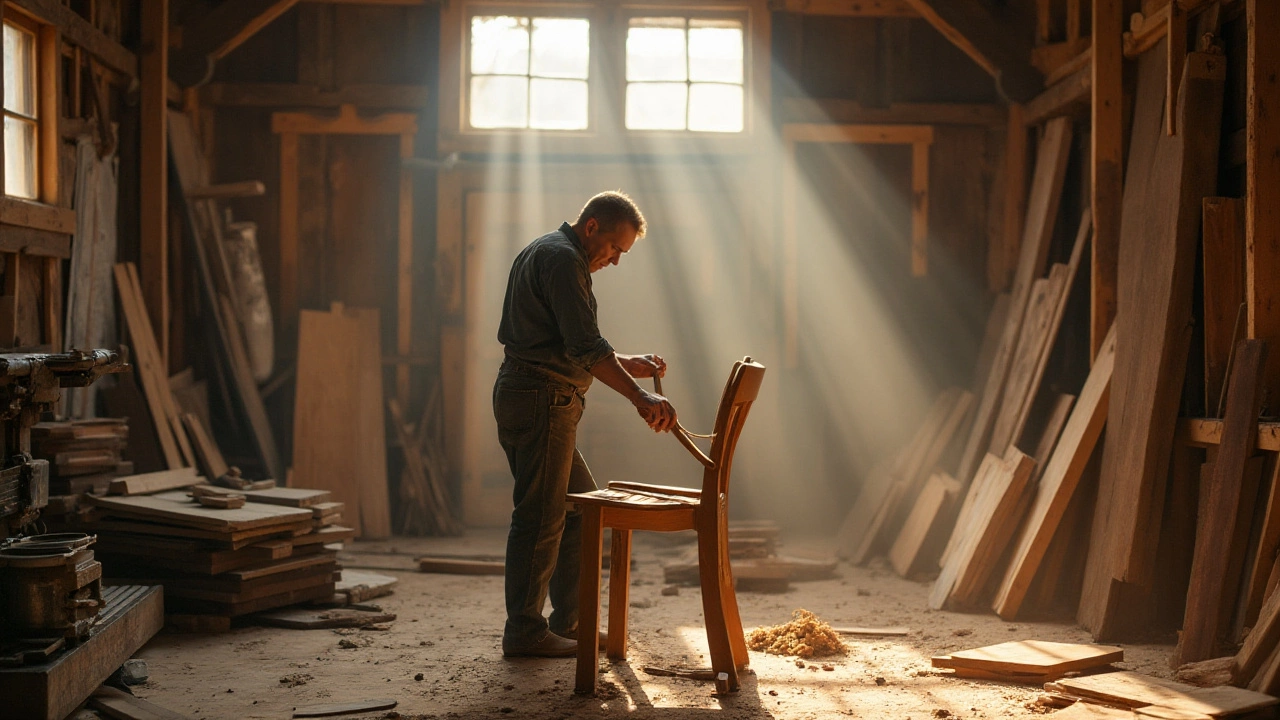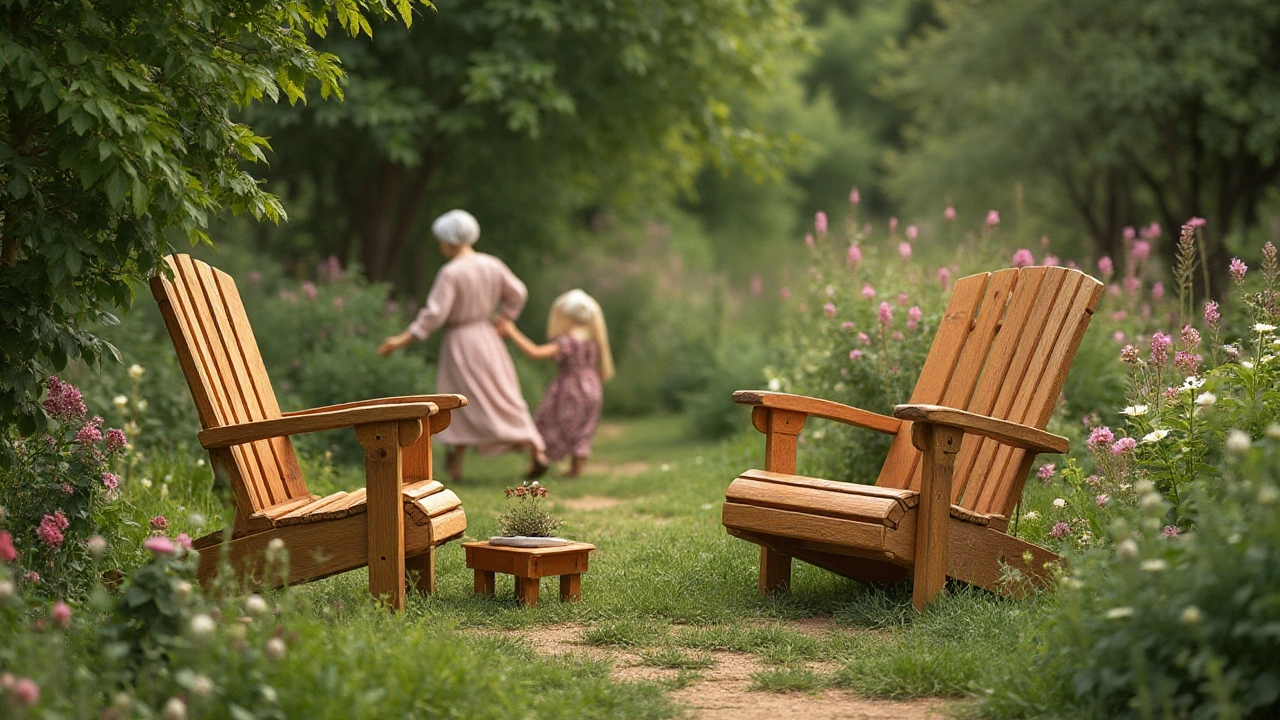The Amish community has long been admired for their commitment to traditional craftsmanship, creating furniture pieces that stand the test of time with their timeless aesthetics and unmatched quality. However, as the world turns a keen eye toward sustainability, new materials like POLYWOOD, made from recycled plastics, have entered the furniture scene. This raises an intriguing question: have the Amish adopted these modern innovations into their cherished furniture-making practices?
Exploring the intersection of Amish traditions and POLYWOOD can offer insights into how age-old values coexist with modern solutions. While the Amish are known for their conservative lifestyle, their underlying principle of sustainability aligns with the eco-friendly characteristics of POLYWOOD, presenting an interesting juxtaposition of old-world techniques and modern material science.
In this article, we delve into the world of Amish garden furniture, examining the potentials of POLYWOOD in this artistic craft. Whether you're a fan of the elegance of wood or curious about how recycled plastics might fit into this narrative, there's much to learn from this unique cultural crossover.
- Traditional Amish Craftsmanship
- Introduction to POLYWOOD Material
- Combining Old World Techniques with Modern Innovations
- Sustainability: A Shared Value
- Future Trends in Amish Furniture
Traditional Amish Craftsmanship
The Amish community is well-known for their meticulous craftsmanship, an art form that has been cherished and passed down through generations. This dedication to making high-quality furniture begins with the selection of materials, often opting for local hardwoods like oak, cherry, and maple, which not only emphasize their commitment to sustainability but also their love for natural beauty. The process itself is a labor of love, where each piece of wood is carefully seasoned and cut manually, allowing the natural characteristics and intrinsic grains to shine through. It's not uncommon for an Amish craftsman to spend several weeks on a single piece, ensuring that it aligns perfectly with the vision of functional simplicity and enduring design.
In addition to using the finest woods, the Amish employ time-honored techniques that reject modern conveniences in favor of traditional tools. This means forgoing electronic saws and opting for hand planers and chisels. Their workshops are often powered by non-electric means, like windmills or air compressors, to align with their principles of simplicity and detachment from modern technology. This adherence to the old ways not only preserves the authenticity and integrity of their work but also nurtures the deep connection and respect they hold for their craft. As you run your hand over the smooth surface of an Amish-crafted chair or table, you're not just feeling wood—you're experiencing a narrative of dedication and skill.
An important aspect of Amish furniture-making is the involvement of the entire community, where craftsmanship is viewed as a collaborative effort rather than a solitary endeavor. This communal approach fosters a sense of belonging and shared purpose. Many Amish artisans start learning their trade at a young age, apprenticing under skilled mentors who pass on not just techniques, but also the philosophies that govern the Amish way of life. This apprenticeship can last several years, slowly fostering both skill and a deep understanding of the balance between individual artistry and communal values. Indeed, it is in this harmony of tradition and community that the brilliance of Amish craftsmanship truly shines.
"The Amish are artisans who practice traditions to make furniture that lasts for generations," states the online publication Amish Country Gazettes. This approach, steeped in tradition and communal involvement, weaves a tapestry of familiarity into the furniture they create.
Visiting an Amish furniture shop is itself a journey into their world—one that emphasizes the value of patience through the intricate methods they use. Each joint is hand-fitted, every curve carved painstakingly with precision, ensuring the finished product is not just a piece of furniture, but an enduring legacy of skill and tradition. Whether it's a simple, elegant rocking chair or a sturdy dining table, each piece narrates a story of humble beginnings and remarkable artistry. The incorporation of dovetail joints without nails or screws is one such example of their ingenuity, showcasing construction methods that speak volumes of durability and beauty, adored by those seeking authenticity in their homes.
Introduction to POLYWOOD Material
Imagine a world where the beauty and elegance of wooden furniture come with zero maintenance and an environmental twist. Welcome to the age of POLYWOOD! This intriguing modern material is a game-changer in the realm of garden furniture, challenging traditional norms while staying true to nature-friendly practices. But what exactly is POLYWOOD, and why is it making waves in both eco-conscious and aesthetic circles?
POLYWOOD is a unique synthetic material crafted from recycled plastics, often composed of milk jugs, detergent bottles, and similar types of waste. What sets it apart is not just the eco-friendly base but its transforming capabilities. Through an innovative process, these plastics are cleaned, crushed, and turned into a high-density polyethylene (HDPE) lumber that mirrors the appearance and feel of natural wood. The result is a durable, weather-resistant product that retains its vibrant color without fading under the harshest outdoor conditions. An interesting fact is that just fifty milk jugs are enough to create a pound of POLYWOOD, reflecting its powerful recycling potential.
The appeal of POLYWOOD extends beyond its sustainable roots. This material boasts superior resilience against rot, splintering, and cracking—common woes of genuine wood, particularly when exposed to the elements. Many manufacturers, recognizing its performance, offer extensive warranties, allowing consumers to invest in garden furniture that provides peace of mind over decades. This self-assurance speaks volumes about the material's proven track record. It’s no surprise that POLYWOOD's low to no maintenance requirement is a huge drawcard for busy households or anyone who wants to enjoy their outdoor spaces without the fuss.
"POLYWOOD represents a beautiful synergy between traditional aesthetics and modern sustainability," says Jane Smith, editor-in-chief at EcoLiving Magazine.
For those who love the intricacies of woodworking, however, it's essential to highlight that POLYWOOD's uniform nature also makes it easier to mold into intricate designs that might otherwise be challenging with natural wood. Intricate carvings, elegant curves, and modern silhouettes are only a concept and mold away, opening new doors for creativity previously limited by the restrictions of grain or defects in natural lumber.
Given its high durability, using POLYWOOD instead of wood in outdoor furniture can also mean substantial savings in the long run. Since there's no need for stains, paints, or other protective coatings, the price of routine furniture care effectively disappears. Plus, cleaning is a breeze, requiring only a quick rinse with soap and water to maintain its pristine look. This ease of maintenance naturally leads us to consider its fit within the Amish values of stewardship and care for one's surroundings.
The rise of POLYWOOD showcases a shift toward integrating sustainability with daily living while not sacrificing the revered charm of ordinary material. As designers and lifestyle enthusiasts continue to explore creative ways to employ sustainable products, POLYWOOD stands at the forefront, embodying a fusion of tradition and forward-thinking idealism.

Combining Old World Techniques with Modern Innovations
The world of Amish craftsmanship is steeped in a deep reverence for tradition, where the art of creating furniture by hand is passed down through generations. The Amish approach woodwork with an eye toward precision and a heart filled with dedication to the task. It's fascinating to consider how such a community might incorporate a modern material like POLYWOOD into their established practices, blending the old with the new in ways that both surprise and impress. Understanding this fusion requires a dive into both the history of Amish furniture-making and the properties of POLYWOOD.
Despite their adherence to time-honored methods, many Amish craftspeople are not resistant to innovation when it aligns with their values. This is where POLYWOOD, crafted from recycled plastics, comes into play. This material is not only durable and resistant to the elements, but its eco-friendly nature is also compelling. Amish furniture makers often embrace sustainability, as it complements their philosophy of living in harmony with the earth. By choosing materials that ensure longevity and reduce environmental impact, Amish artisans can maintain their foundational principles while taking advantage of modern advancements.
Interestingly, while the Amish typically avoid electricity in the workshop for religious reasons, they sometimes adapt modern conveniences driven by alternative energy sources like bicentennial air compressors. This creativity keeps the process both traditional and surprisingly effective, allowing a space for materials like POLYWOOD to be integrated without compromising authenticity. In practical application, the adaptability of this resistant material can enhance the durability of outdoor furniture, a perfect fit for the Amish's meticulous attention to life-long utility.
Including POLYWOOD in garden furniture allows these craftsmen to experiment with innovative designs that meet the contemporary demand for eco-conscious products while holding steadfast to handmade excellence. For instance, using POLYWOOD alongside traditional woods creates striking contrasts and expands the artistic possibilities, giving furniture a unique aesthetic that appeals to modern tastes. This melding of materials also raises a broader awareness of sustainable practices within the buyer's space, offering a conversation starter and a testament to evolved practices.
"The beauty of tradition does not come at the expense of progress. Adopting thoughtful innovation can preserve the past while paving the way for the future." – A noted expert in sustainable design
Data suggests that consumers increasingly value sustainability, with a growing percentage indicating preference for eco-friendly products. This aligns seamlessly with Amish ethics and their cautious yet sagacious adoption of materials like POLYWOOD. In this harmonious integration, the marriage of Amish furniture's timeless craftsmanship with cutting-edge materials not only preserves its appeal but elevates it. Those eager to enjoy luxuriant garden settings without sacrificing their green ideals find perfect partners in Amish furniture enhanced by POLYWOOD.
Sustainability: A Shared Value
The Amish community is often recognized for their sustainability practices, a concept woven into the fabric of their daily lives. With a focus on simplicity and efficiency, they actively create a self-sustaining environment, whether it be through farming methods that conserve resources or crafting furniture that resists the wear of time. This harmony with nature makes the Amish uniquely aligned with the principles driving the development of eco-friendly materials like POLYWOOD.
Understanding the peculiarities of Amish life reveals why they might embrace a material like POLYWOOD, despite it seeming modern by their standards. Made from recycled plastics, POLYWOOD not only saves significant amounts of waste from ending up in landfills but also provides durability and longevity that mirrors the lasting nature of traditional Amish furniture. Remarkably, the lifecycle of POLYWOOD could be seen as an extension of the Amish ethos, which cherishes preservation and sustenance of resources across generations.
There are facets of sustainability which are rarely mentioned yet inherently understood by the Amish. Their processes naturally limit impact, focusing on conscious consumption and minimalistic living—all factors essential to safeguarding the planet's future. The journey from raw recycled materials to functional garden furniture crafted from POLYWOOD exemplifies a circular economy model, something the Amish inadvertently practice in their daily lifestyle.
Despite the modernity it represents, the use of POLYWOOD mirrors the Amish principle of 'waste not, want not.' By viewing these elements through a shared lens, a newfound respect arises for how traditional values might color acceptance of contemporary materials. Even experts recognize this overlap. As renowned environmentalist Lester Brown posits, "When we see environment and society through the same lens, we foster a synergy that transforms the world."
In considering future applications and the role of such materials, one appreciates both the potential challenges and the intersections with existing antique practices. As the world turns its eyes to sustainable solutions to cope with resource depletion, possibilities of synergy between historical wisdom and modern innovation come to light. POLYWOOD provides a unique insight into how a modern, eco-friendly product aligns with century-old values cherished by groups like the Amish—a testament to both the material's versatility and the timelessness of the human ingenuity at living in equilibrium with nature.

Future Trends in Amish Furniture
As technology evolves, the furniture industry reflects these changes, with new materials and design philosophies emerging on a regular basis. The Amish community, renowned for their meticulous craftsmanship and sustainability-focused practices, is no stranger to these shifts, albeit in their distinctive, traditional manner. Despite their conservative approach, there's a newfound interest in integrating environmentally friendly innovations like POLYWOOD into Amish furniture, leading to a potential blend of old-world charm and modern sustainability.
The future of Amish furniture lies in delicately balancing tradition with innovation. While traditional solid wood remains a staple due to its aesthetic appeal and durability, materials like POLYWOOD fit well with their sustainable values. Given that this material is made from over 90% recycled plastics, there's a tiny yet significant shift towards considering its use, creating a unique opportunity for the intersection of historic craftsmanship and cutting-edge environmentalism. This shift can redefine how the Amish produce garden furniture, allowing them to appeal to a broader, eco-conscious clientele.
Consumers today are more informed and ethically driven, seeking products that reflect their own values. With their longstanding commitment to sustainability and ethical practices, the Amish can leverage these environmental trends to their advantage. Harnessing new technologies like solar-powered tools could revolutionize their craftsmanship without compromising their dedication to low-impact practices. A study conducted by the Environmental Design Program at a leading university showed that businesses integrating eco-friendly practices often see a 20% increase in consumer loyalty, emphasizing the market for such approaches.
Expanding production to include POLYWOOD options doesn't just cater to environmental trends but also opens new avenues in the multi-billion-dollar eco-furniture market. The incorporation of vibrant color palettes available in POLYWOOD can provide customization options while maintaining the structural integrity that is synonymous with Amish furniture. This adaptability can be pivotal for staying relevant in a rapidly evolving market, further cementing their status as a hallmark of quality.
"The Amish community's focus on quality hasn't wavered, and as we look ahead, we see a promising fusion of tradition and technology that respects both the past and the planet," states an industry expert from a respected green building forum.As they continue to explore these possibilities, the Amish may find themselves at the forefront of not just artisanal woodworking, but also eco-friendly innovation, proving yet again that true craftsmanship knows no bounds, regardless of technological advancements.
The seeds planted today in sustainable practices can grow into a forest of opportunities for the Amish furniture industry. By tapping into their roots while embracing modern materials like POLYWOOD, they could redefine what it means to craft with conscience, setting new standards for furniture-making that honors both heritage and the earth's future.



